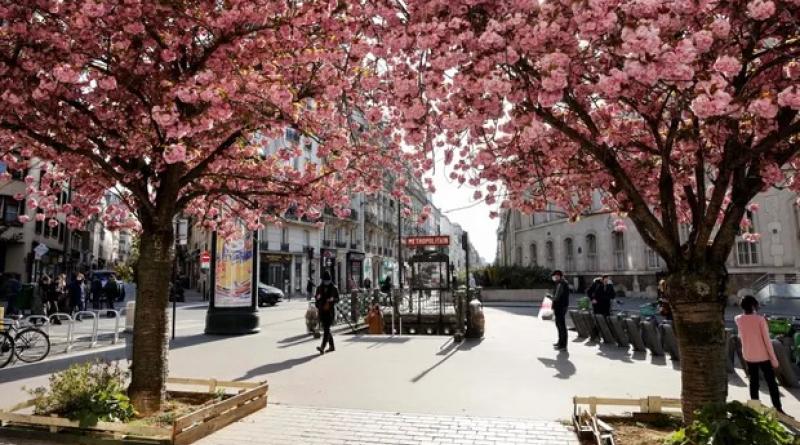‘We need trees’: green vision struggles to take root in Europe’s cities

Planners want to plant trees to tackle climate crisis but often face a hostile urban environment
From Madrid to Berlin and Paris to Budapest, scientists and planners agree, trees, trees and yet more trees can help make Europe’s cities more comfortable – even survivable – over the coming years, as global heating strengthens its grip.
But concrete pavements, high-rise buildings, historical squares and underground car parks are a hostile environment for trees, and authorities are finding it hard to plant more. In fact, many EU cities are less green than they were a century ago.
“It’s a massive challenge,” said Christophe Najdovski, the deputy mayor for revegetation and green spaces on Paris city council. “We know with enough trees we can lower the city’s summer temperature by up to 8C. They’re basically natural air-conditioning. But planting them isn’t always easy.”
The latest report from the Intergovernmental Panel on Climate Change could not be much clearer: trees in cities combat climate change both directly, by storing carbon, and indirectly, by cooling urban areas down – reducing energy demands.
They also offer city dwellers what the report calls “multiple co-benefits”: improved air quality, reduced heat stress, fewer “urban heat islands” caused by streets and buildings absorbing and retaining heat, “improving mental and physical health”.
For city halls, in short, planting more trees should be a no-brainer. But according to the Organisation for Economic Co-operation and Development, tree numbers in many of Europe’s cities have been falling since the early 1990s, with some large conurbations losing as much as 10% of their cover.
In part, experts say, that is because older trees from the late 19th and early 20th centuries – those that have survived successive generations of urban planners’ efforts to make more space for cars – are starting to reach the end of their lives.
But it is also because of the technical difficulties, and cost, of planting new trees. According to Ana Luisa Soares, a landscape architect at the University of Lisbon, a new tree can cost a city administration as much as €2,000 (£1,740) over five years.
“You need to buy the tree,” Soares said. “You have to plant it, water it – especially in the first five years, when it is most vulnerable. Life is hard for a tree in a city: compacted soil, polluted air … You have to maintain it, prune it, treat it for disease. When you’re talking tens of thousands of trees, it’s a huge investment.”
The advantages, for city dwellers, seem clear. “We need trees,” she said. “They are important for all of us, residents and visitors. They give us more shade, better air quality, lower temperatures, natural beauty – basically, more trees mean happier people. We know this. And they will be even more vital in the future.”
But while the costs are easily quantifiable, the benefits are less so. Worse, said Soares, the environmental, social, economic, aesthetic, and health benefits trees provide “are often simply ignored, because cities are looking simply at managing costs”.
In an effort to put a monetary value on trees’ benefits, Soares adapted a US software program, iTrees, and fed it data from Lisbon’s 41,000-odd trees. She found that while the trees cost about $1.9m annually, the services they provided were worth $8.4m.
“So for every $1 a city invests in its trees, residents get about $4.5 in benefits,” she said: energy savings of about $6.20 per tree, carbon reduction worth $0.33, removal of air pollution $5.40, and reduced stormwater runoff $47.80. Trees were also found to add significantly to property values.
The European Commission last year proposed a draft regulation requiring the bloc’s 27 member states to ensure that at least 10% of the surface area of all cities, towns and suburbs be planted with trees by 2050, and to commit to no loss of green space
But cost is not the only obstacle facing city planners. Often, said Najdovski at Paris’s Socialist and Green-controlled city hall – which over the past two years has embarked on one of Europe’s most ambitious tree-planting programmes - cities simply cannot plant trees where they would like.
“The biggest issue is underground infrastructure. The metro, gas pipes, power and phone cables, car parks … You need a certain depth of soil under a tree. We would love to plant all along the rue de Rivoli, which crosses the city centre from east to west, but unfortunately the metro is directly underneath.”
Elsewhere, guaranteeing access for emergency vehicles along narrow streets can prove an obstacle, as can heritage laws preventing trees from being planted on or near buildings, streets and squares that were not designed for them. Most big squares in Europe’s cities were conceived as open spaces, with imposing views.
“That’s the case in Paris with, for example, the Place de la Concorde or the Avenue de l’Opéra,” Najdovski said. “The city architects argue they should stay as first designed, unadorned with trees, and that the view of the Opéra Garnier cannot be obscured or spoiled. We are looking to compromise, but it’s not straightforward.”
On other major arteries such as the Avenue de Wagram, however, Paris is busy replanting trees that were uprooted in their tens of thousands during the 20th century as the city transformed grand boulevards, lined on both sides by double rows of trees, into four-lane avenues with roadside parking.
“Essentially,” said Najdovski, “we aim to significantly reduce the space reserved in Paris for cars, and to use as much of it as we can to plant trees: a massive revegetation programme, the reconquest of nature over the automobile. The objective is to plant trees in large numbers and wherever possible.”
Since its re-election in 2020, the council has planted 38,500 new trees in the capital, including 18,000 on the embankments of the péripherique ringroad, 12,000 in the Bois de Boulogne and de Vincennes, and 8,000 on city centre streets and squares.
It aims to plant a further 21,000 this winter, including 11,000 around the ringroad and 800 in 80 more city-centre streets. The city is also planning three “urban forests” mainly in the east of the city, including one on 3.5 hectares (8.65 acres) of former railway sidings in the 20th arrondissement that will be home to 2,000 new trees by 2024.
Its final target, by the end of its six-year mandate, is 170,000 new trees, including 20,000 on inner-city streets. Paris’s traditional plane trees will mostly dominate, but some Mediterranean species – such as the holm oak, more resistant to warmer temperatures – are also being introduced.
As has happened in Brussels, where a 10-year plan canopée (or canopy plan) aims to preserve the city’s existing trees and plant several hundred new ones each year until 2030, Paris city hall’s plans have sparked sometimes heated protest, most notably from motorists’ organisations.
“Like I said, it’s not always easy, and motorists’ and residents’ objections are just one of the many issues we face,” said Najdovski. “Some residents say to me, look, I don’t want trees outside my apartment – they’ll cut out the light, that’ll knock thousands off the asking price,” he said.
“I say to them: when summers in Paris start regularly hitting 40C or 50C, what do you think your flat will be worth then? If the city is basically unliveable, who loses most?”
COVER PHOTO: Cherry blossom trees outside a metro station in Paris. Photograph: Ludovic Marin/AFP/Getty Images





